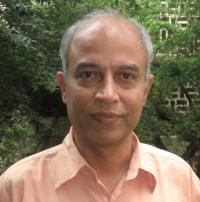Portfolio
EducationSpoken Tutorials
“Education is the fundamental building block for the advancement of individuals & societies along with mutual respect and fairness. Innovative solutions that address education inequities and barriers (quality content, qualified teachers, access, affordability), and creates means towards dignified livelihoods & fair standards-of-living all over the world”

Kannan Moudgalya
Founder Story
Spoken Tutorials (ST) is an amazing innovation coming out of years of pioneering research led by Professor Kannan Moudgalya nearly a decade ago at one of India’s premier engineering institutions – Indian Institute of Technology in Bombay (IIT-B). With initial funding from Government of India, Dr Kannan took on the challenge of making it possible to learn & master computer & software skills for masses living in remote parts of the country at a price of few pennies! Like many countries of the world, whether a developing or developed economy, India faces the urgent need to enable millions of youth entering the workforce ready for the skills needed for the new digital world. Every industry in the world is rapidly transitioning from old structures to the one underpinned by information technology at its core. Speed of this transition has created millions of unfilled jobs due to lack of workers with needed IT skills. Current options of acquiring these skills in either technology oriented higher-degree educational institutions or in private training centers limit their availability to mostly urban population centers and for those with much higher income levels. In most of the developing economies, including India, this results into a very large portion of eligible workforce being left out of digital transition. Even in developing countries like USA, accessibility & affordability barriers risk further widening of education and economic inequity in the society. Further, lack of enough numbers of quality instructors results in sub-standard teaching at many existing learning centers. Lastly, the learners from non-English native language geographies face huge language hurdles in this skills domain that has nothing inherent about English. Spoken Tutorials is designed to eliminate all these barriers and enable the world-at-large ready for the new digitized world. Dr Kannan graduated in 1985 with a PhD in Chemical Engineering from Rice University, Houston and began his career as a Research Associate at the Chemical Process Modelling and Control Research Center at Lehigh University in USA. In 1988 he became Assistant Professor at IIT-B, and has since worked his way up to the position of Erach and Meheroo Mehta Advanced Education Technology Chair Professor. He has written several books including the recently published “Digital Control” and another one (“Optimization: Theory and Practice”) with M. C. Joshi. ST innovation has won numerous awards & recognitions such as Google MOOCs Research Award, Reimagine Education Award 2015 by QT and Wharton School, Re-Engineering India Award, and has been featured on the TEDx platform.
Interview with Founder- Kannan Moudgalya
Description and Compelling Attributes
ST provides an active learning method for any new educational topic in short and simple steps for learning in any language native to the learner. While the initial impetus of the innovation has been information technology topics, from basics (e.g., introduction to computers) to advance courses in demand for high-paying jobs (e.g., Python, mySQL, Java), ST platform has been expanded to cover new learning topics such as nutritional health for new mothers & babies.
At the core of it, a spoken tutorial is a an audio-video tutorial that explains an activity, on the computer screen (where it is typically viewed). An expert explains the working of the topic (e.g., a software language such as C++), by demonstrating it on the screen, along with a running commentary. A screencast software makes a movie of the entire activity, both the screen and the spoken part. This movie is the spoken tutorial. The running commentary can be in English or in any other language. Spoken tutorial is a recording of an actual session. As a result, it can capture every step that is required to explain an activity. While simple in concept, the final product (a series of 10-minute tutorials – which could be as few as half-a-dozen to as many as several hundreds, depending upon the breadth & complexity of the topic) requires proper integration of right instructor, content structure & sequencing, well-choreographed content script, user-interface, and transposition into A/V modules suitable for average learner. These ST modules are purposely created for consumption flexibility with or without access to Internet connection. Hence, the size of the video created is of the order of 1MB per minute, for a 800×600 screen size in normal resolution. The resulting file size is small enough for transmission through low bandwidth and also to pack a large number of tutorials on a single inexpensive storage device (e.g., USB stick or CD or DVD), enabling distribution to remote rural locations.
Further, the overall design & packaging has been done to enable easy dubbing of audio portion in any language that a remote / rural learner feels comfortable with. Many of the existing STs have been dubbed in more than 22 languages spoken within & outside India. Since many proprietary IT softwares are owned by large multinationals, their licensing costs make them unaffordable for large-scale usage in many emerging countries. This has resulted in huge development of open-source software technology options across the IT spectrum. To support this, current library of STs cover most of the popular open source software families, such as LaTeX, Scilab, GNU/Linux, and Python. While only a small topic can be covered in the standard ten-minute long single ST, by stringing them together, one can easily create study plans that are capable of teaching advanced topics.
Two other critical features of ST approach are emphasis on the application of learning, and linkages to current market needs and challenges. While playing the ST, the learner, applies the course elements right away by practicing on the computer side-by-side. Combination of the flexibility (to learn at one’s choice of location, timing, duration, and pace) and real-time application makes it very powerful learning innovation tool. After finishing all the STs for a course, learner can take the examination to test their competency and can compare their scores pre and post learning. Score and associated details of the course outline are covered in the completion Certificate making it easy for a prospective employer to feel confident in the learner’s fit & employability.
As of end of 2021, STs have already been used by more than 7 million learners across 6000+ schools, colleges and universities worldwide. These learners have been located in some of the most remote and disadvantaged sections of the society.
Replicability
ST’s business model efficiency lends it to be a perfect innovation for masses! Once a particular topic ST series has been developed, that one-time investment cost gets spread over hundreds of millions of users. With minimal ongoing operational expenses (maintenance, support, scoring, certifications, etc), individual learner pricing becomes affordable to the poorest of the population. STs can be offered through various channels – Schools, Colleges, Universities, learning centers (private, public), libraries, corporations, government centers etc. Further, pricing & packaging can be easily tailored to suit local affordability, immediate market needs, and setup. Both enterprise licensing & pricing and individual learner options are easy to implement. Either way the learners can now have option of acquiring new digital economy skills at a tiny fraction of current options. More importantly, that learning can be done at a massive scale of hundreds of millions concurrently.
With already existing library of large number of STs and coverage of 22+ languages, any entrepreneur can quickly setup a learning facility in their town or collaborate with the existing educational institution and/or government agencies. Main investment is in the form of computers to practice what is being learned. For example, a facility with twenty computers can be used by that many learners in 30-min or 60-min time slices enabling 300-400 learning sessions every day. If additional languages and/or topics need to be covered, the incremental investment is fairly low, likely to be in few thousand dollars (depending upon the number of ST modules needed to cover the topic). The effort can leverage local talent to reduce the costs and time to market.
ST innovation is ready to eliminate digital economy education barriers in every corner of the world, and to be embraced by passionate entrepreneurs who want to lead that digital transformation of their country.
Futures
ST platform makes it possible to imagine a world of educational & economic equity. In the new world of digital economy, IT literacy (from basics to advanced topics) is the new currency to achieve desired standards of living. ST offers the promise to enable all learners to leap over their current barriers (accessibility, affordability, reach, quality) and have equal chance in that new world. Further, any desirable change (for new methods, practices, behaviors) first require the target group to be educated on the relevant topics and materials. ST enables that at a fraction of cost and at a scale for masses. Imagine rapidly educating hundreds of millions on new health & wellness techniques & practices, civic education, government services, and on & on. Sky is the limit.
We invite all entrepreneurs to leverage ST innovation platform to accelerate their economies’ transition to digital economy and achieve education and economic equity for all.
We invite ALL who are education-cause-focused entrepreneurs and entities (private, public, NGOs) looking to transform the education and learning landscape in their towns and countries. We invite ALL content experts and providers to bring their content to benefit masses and targets ALL over the world not just in their neighborhoods.

